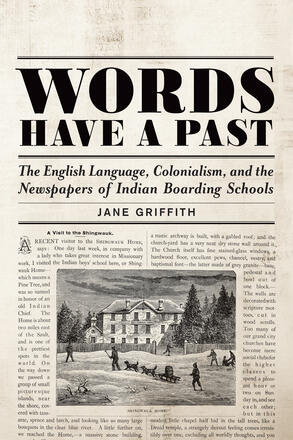
Words Have a Past
The English Language, Colonialism, and the Newspapers of Indian Boarding Schools
Description
For nearly 100 years, Indian boarding schools in Canada and the US produced newspapers read by white settlers, government officials, and Indigenous parents. These newspapers were used as a settler colonial tool, yet within these tightly controlled narratives there also existed sites of resistance. This book traces colonial narratives of language, time, and place from the 19th century to the present day, post-Truth and Reconciliation Commission.
Awards
- Winner, International Council for Canadian Studies Pierre Savard Award 2022
- Winner, Best Book Prize awarded by The Canadian Studies Network- Réseau d'études canadiennes 2021
Reviews
"Griffith has produced a nuanced exploration of the tensions and contradictions that not only marked the past in the form of the Residential School system, but has always existed and continues to exist in a web of related assumptions. "
- Anne Lindsay
"[Words Have a Past] is a marvelous exploration of the language of colonialism, how the English language was cast as an innocent neutral force, and how this continues to be reflected in contemporary Canada. The book is easily accessible for all readers, well researched, and documented. It is simply a must-read that will aid in developing a deeper understanding of language, and colonialism roots and their ongoing impact in the present."
- Karl Hele, Mount Allison University
"Words Have a Past marks an important step in the study of residential school history by drawing our attention to newspapers as important historical sources, and the printing trade as an influential part of some students’ experiences. Further, in anchoring the book within critical Indigenous and Settler Colonial studies, Griffith provides a direction for scholarship on residential schooling that challenges approaches that situate the system wholly in the past; as a result of her conclusions, Griffith explicitly calls for justice and restitution—especially as it relates to language reclamation—for survivors and their communities. This is an essential read for those studying the residential school system, settler colonialism, history of media, and Canadian history."
- Natalie Cross and Thomas Peace, Huron University College
"Words Have a Past is an important contribution to the ongoing conversation on the assimilation policies of the Indigenous boarding school systems in North America, and importantly, Griffith’s message of settler responsibility and restitution for Indigenous linguicide and land loss is essential for all settlers to hear."
- Carling Beninger, University of Alberta
"In this well researched and highly readable book, Jane Griffith analyzes six newspapers published in the late nineteenth and early twentieth century by five Indian boarding schools."
- Shurli Makmillen, Claflin University